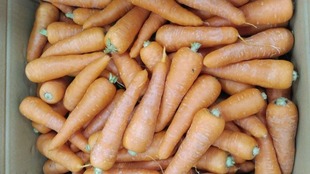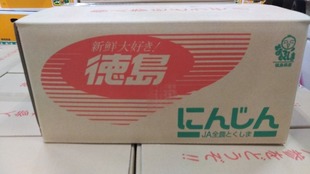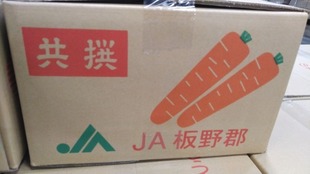Daucus carota subsp. sativus
It’s said that the root was named because it looks like a head, legs and hands and has a human-like shape.
About “inspection and evaluation of goals and activities for achieving them” and “setting of goals for optimization activities” by the Agricultural Commission. On June 8, 2022, the Agricultural Commission will promote the optimization of the use of agricultural land, such as the accumulation and consolidation of agricultural land, the prevention and elimination of idle farmland, and the promotion of new entrants, in accordance with the Act on Agricultural Commission, etc. It seems that such activities will be carried out. In order to make the optimization activities transparent and appropriate, we plan to announce the inspection, evaluation, and goals of the activities, the status of promotion of optimization of agricultural land use, and the implementation status of other office work by the Agricultural Committee. In 1988, six JAs in the eastern part of the Itano District of Tokushima Prefecture merged as “JA Itano”, and in 2000, six towns, Itano Town, Aizumi Town, Kitajima Town, Kamiita Town, Yoshino Town, and Donari Town, became “JA”. Established as “Itano District”. As an agricultural cooperative in those areas, the JA seems to operate a comprehensive business closely related to every aspect of daily life. The Itano District Agricultural Cooperative is located in the northeastern part of Tokushima Prefecture, on the north bank of the middle and lower reaches of the Yoshino River, one of Japan’s leading rivers. The area has developed as one of the prefecture’s leading agricultural production areas, mainly carrots, lettuce, and lotus roots, taking advantage of the abundant water resources of the Yoshino River and the location conditions centered on offshore soil, and taking advantage of the warm climate of Setouchi. It seems. In recent years, with the progress of urbanization, the distribution of people and goods has dramatically increased due to the opening of the Akashi Strait Bridge and the extension of the Shikoku Transit Expressway, although there are severe problems such as a decrease in production areas, an aging population, and a shortage of workers. It seems that it is expected that these ripple effects will increase and lead to the activation of regional agriculture. Cultivation of special carrots began in earnest around 1968, and has rapidly spread and established since then. In 2004, the number of production units was 372 houses and the cultivation area was 525 ha. In 1990, it won the Japan Agricultural Prize Gold Award and has gained fame as a leading production center. It seems that the cropping patterns from the Showa era are mainly those that are sown from late October to mid-December and harvested from late March to late May. The first priority is to prepare the conditions for seed germination and initial growth, and the mechanized integrated system is used to carry out tillage, ridge-raising, sowing, herbicide spraying, and coating in one day to maintain soil moisture. It seems that the sowing method has been successful. There are two types of tunnel covering materials, film width 3.6 m and 6.0 m (as much as 5.4 m). Recently, due to the workability and yield in the tunnel, the 6 m type has rapidly become widespread, and the total It seems to occupy 85%. In addition, it seems that the hem is completely filled with soil in the furrows so that the film will not be blown off by the winter monsoon or early spring wind. In addition, as a result of field tests, olefin-based (non-vinyl chloride: generally PVC (polyvinyl chloride, PVC) may generate harmful substances including chlorine when incinerated. Also, it is contained in vinyl chloride. Some of the substances used as plasticizers (phthalates) and stabilizers are concerned about environmental and human effects. Perforated film (perforated on the entire surface of the film) It is used as a packaging bag for food. There are two uses for degassing and degassing. First, degassing is the moisture inside the film. It means that it is prevented from being muffled. For example, in rice etc., there is a concern that mold may be generated due to the dampness, so there is a high need for measures against moisture because of the high humidity in Japan, and the entire surface for degassing. (Demand for perforated film is high) improves quality and yield, and is effective especially in the case of early incinerator, so it seems that it has become widespread and established. In addition, referring to past test results, the nitrogen application rate should be 15 kg per 10 a in upland fields and 20 kg in paddy field conversion. It seems that it is carried out systematically. Regarding the ventilation of tunnel cultivation, it seems that an ideally balanced ventilation is performed by installing a ventilation model field with a thermometer and referring to the data. The appropriate amount for composting is about 4 tons, and the effect seems to be remarkable. At 6 t, the base balance is lost and the absorption of Ca and Mg deteriorates, which seems to have a bad effect on growth hypertrophy. Based on the idea that soil preparation is the basis of cultivation, more than 1,200 soil analyzes are conducted annually, and seminars on analysis and diagnosis are held to promote rationalization of fertilization without difficulty, and to improve soil fertility and high quality-oriented production. It seems that they are trying to level. In 1992, before the compost supply center was established, the soil humus value was low, and the cultivated area with a target value of 2.0% or more was 4% of the total (corresponding area 18 ha), and in 2003 it was 66.0% (corresponding area 346 ha). It seems that the ripple effect of compost supply and enlightenment was noticeable. As an effect of the fertilizer component announced by Tokushima Prefecture, nitrogen is effective for leafy vegetables such as Chinese cabbage, cabbage and spinach as it is called leaf fertilizer, but if it is overdone for bean vegetables, only leaves will grow. Phosphoric acid seems to be effective for fruit-bearing vegetables such as tomatoes, cucumbers, and watermelons, as it is called fruit fertilizer. Potash fertilizer thickens the roots and makes them strong, so called root fertilizer, so it seems to be effective for root vegetables such as potatoes and sweet potatoes. In addition, it is advisable to carry out a soil diagnosis before application and try to ensure an appropriate input amount. Unlike chemical fertilizers, the effect of fertilizer seems to appear slowly by continuing to use it every year. When applying, be sure to mix well with soil 1 to 2 months before planting. Since cow manure is often high in potash and pig manure is high in phosphoric acid, the nutrient balance is likely to be lost, so do not apply more than necessary and try to supplement the fertilizer components with chemical fertilizers. The “Ordinance on Prevention of Unreasonably Large Application of Fertilizer, etc. in Tokushima Prefecture” has been enforced since 2007, and the ordinance will be observed when applying. Also, after spraying compost, try to cultivate it promptly. Since 1997, the “Spring-Summer Carrot Organic Village Development Study Group” has endeavored to improve soil fertilizer by adding pesticide-reduced cultivation and compost and organic fertilizer made from livestock manure supplied by livestock farmers in the same JA jurisdiction. It seems that it was organized by producers, agricultural cooperatives, and prefectures with the aim of establishing an environment-friendly cultivation method such as reducing the underground outflow of fertilizer components by making proper soil and preventing the pollution of groundwater. Based on soil preparation, summer sorghum (grass of the Gramineae family, also known as great millet, takakibi, kolyan, etc.) is added, high-quality compost (4 t / 10a), and all-organic fertilizer (“JA Organic Village 5.5.” 4 ”240 kg / 10 a, 40% reduction of practice), seems to be working with the goal of environmentally friendly production. It seems that carrot shipments and sales require planned and leveled shipments from late March to late May. For this reason, it seems that they are trying to set up a growth measurement field, link this growth data with AMeDAS data, formulate a shipping forecast formula, adjust the appropriate distribution, and level the shipment. In addition, nine specialist inspectors have been assigned to the collection and shipping area, and it seems that they are trying to eliminate quality disparities by thoroughly managing standards. Furthermore, it seems that the women’s department is working to improve stable supply and market trust through campaigns at mass retailers and repeated market visits. In addition, we have developed efforts to give consumers a higher sense of security, such as thorough recording of production history, promotion of proper control, and implementation of pesticide residue analysis, and have been highly evaluated. About 20 years have been described, but the JA has 8738 houses (regular members: 5585 houses, associate members: 3153 houses) in 2019, and the transaction volume of the sales business is 7.3 billion of vegetables, fruits and flowers. It seems that it was 60 million yen, rice 550 million yen, and livestock 15 million yen. In the jurisdiction, in addition to carrots, it seems that they are working on the production of various vegetables such as lotus root, which is a special product of Tokushima prefecture, Kintoki sweet potato (Kitajima town), broccoli, lettuce, cauliflower, and turnip. The cultivated area of carrots in the jurisdiction in 2020 was 654 hectares, which seems to occupy about two-thirds of the planted area in Tokushima Prefecture. Among them, Itano Town and Aizumi Town seem to be the main carrot cultivation areas. However, since Aizumi Town, including Kitajima Town, is adjacent to Tokushima City, which is the center of Tokushima Prefecture, the population has increased and concentrated significantly as a commuter town, and it seems that the conversion of agricultural land to residential land has progressed. Therefore, it seems that some farmers are taking measures to secure the shipment volume by giving crops to neighboring Ishii Town, Yoshinogawa City, and Awa City. In addition, the number of farm households is declining to 228 houses in 2020, but the age group is thick in the 40s to 60s, and it seems that successors are growing to some extent. In terms of cultivation, Ayahomare carrot from Fujii Seed Co., Ltd. (Yodogawa Ward, Osaka) (wase species with excellent shape, root color, and yield. The root length is 16 to 19 cm, the shape is slightly shouldered, and the yield is good, that is, the yield. Good nature. Both root color and core color are bright deep red, and the boundary of the core is almost inconspicuous. Also, the skin is smooth and the packaging after washing is very beautiful. The above-ground part is upright and slightly vigorous. It is resistant to illness and seems to be lush until harvest. Also, it seems that the occurrence of blue neck is rarely seen because it is highly inhalable. Since the moss is about Koyo No. 2 carrot, avoid using it in unreasonable cropping. The main varieties (about 70%) are cultivated to make the best use of their sexuality and try to harvest at the right time.) In the early 2000s, a mechanized system from the installation of a greenhouse tunnel to sowing and harvesting was established, especially in 1990. It seems that the harvesters that became popular in the 1980s were effective in maintaining and expanding the area. Cultivation using the tunnel green house seems to be a major feature of this production area. It seems that they are pursuing the sweetness and softness of the product by making appropriate holes in the coated vinyl and thoroughly controlling the temperature inside the tunnel. The cost of the tunnel greenhouse is pipe (usable for 15 years), vinyl (renewed every year), and harvester (renewed once every 3 to 4 years for 5 to 6 hectare producers) per 10 ares, so it is cultivated in the open field. It seems that it is difficult to reduce the cost, although the amount is not stated compared to the competing production areas. Due to these circumstances, it is desirable to think that the production area has focused on advantageous sales for households, which emphasized high quality, rather than for commercial use, which requires low prices. There are few farmers who specialize in carrots, and the average yield is 5.2 to 5.3 tons, and it seems that more than 80% of the harvest in the jurisdiction is shipped through agricultural cooperatives. Spring carrots harvested in spring (March-May) beyond the cold winter seem to be grown in a large tunnel greenhouse. Spring carrots in Tokushima are characterized by being “soft and sweet” because they grow in a dry state in a tunnel greenhouse that is not exposed to rain, and are known all over the country and have many fans. In addition, the shipment volume of spring and summer carrots in Tokushima Prefecture is the highest in Japan, and the annual production volume seems to be the third highest in Japan after Hokkaido and Chiba Prefectures. The Itano District Aizono Carrot Subcommittee is Tokushima Prefecture’s original “Tokushima anan(安2)agricultural products” in order to build a face-to-face relationship with consumers and promote the creation of a brand that allows them to experience “safety,” “reassurance,” and “trust.” GAP: Under the new system, in addition to the existing “food safety”, an excellent agricultural production system that considers “environmental conservation” and “occupational safety” will be certified, and the “certification mark” will be displayed on the certified agricultural products. A system that informs consumers of where to obtain product information) ”certification system / Tokushima Prefecture Governor Certification No. 005 has been obtained. The main production areas of the JA are Matsuzaka, Sakae, Itani, Aien, Sumiyoshi, Matsushima, Takashi, and Oyama. Sowing is started in October, cultivated in a large tunnel, and shipped from early spring over the cold winter. Because it grows in a dry state without being exposed to rain due to the coating, it seems that the sweetness is condensed like a drained tomato. It features a bright orange color realized by the careful care of the producer, a moist and smooth fresh texture, a sweet scent and a refreshing flavor.






0 件のコメント:
コメントを投稿